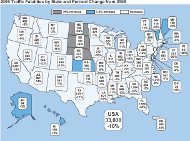State Traffic Safety Efforts Focus on Rare Incidents
High-profile traffic safety campaigns are being mounted at the state and federal levels against behavior that rarely causes the most serious types of accidents. In the past several years, lawmakers have enacted measures designed to increase the punishments for driving past stopped school buses in the name of protecting children. They have also enacted “move over” laws to stop police officers from being killed at the roadside. Statistics released this month by the National Highway Traffic Safety Administration (NHTSA) indicate that accidents involving either situation are exceedingly rare.
Out of the 30,797 fatalities in 2009, 21 involved a school bus and people walking nearby. Of these, however, 13 were caused by the bus driver slamming into the pedestrians — including 7 children under the age of fifteen. Motorists were the cause in only 8 fatal accidents, or 0.0026 percent of motor vehicle fatalities. Despite the risk level, states have ramped up the penalties for passing a stopped school bus. West Virginia authorized private companies to use photo enforcement cameras on school buses last year in the name of saving children from this type of accident. Other states like Virginia impose a penalty of up to $2500.
Forty-nine states impose similarly stiff penalties for passing a police vehicle stopped on the side of the road without first changing lanes. These so-called “move over” laws were adopted in the name of saving the lives of law enforcement officers, but according to the NHTSA analysis, “Characteristics of Law Enforcement Officers’ Fatalities in Motor Vehicle Crashes,” there were only 16 accidents involving police officers stopped in a traffic lane from 1982 to 2008 ( view report, 650k PDF). In fact, of all types of collisions involving a law enforcement vehicle striking or being struck by another car, there were 15 police driver fatalities in 2009, according to the latest edition of NHTSA’s “Traffic Safety Facts.” This represents 0.05 percent of all traffic fatalities.
Some lawmakers frequently tout red light cameras as saving lives from one of the most common types of collisions. There were 454 intersection-related fatalities in 2009. This figure is, however, much broader than incidents caused by red light running. NHTSA’s defines intersection-related accidents as those in which “the first harmful event occurs within the limits of an intersection or at an approach to or exit from an intersection only within a non-interchange area.” This would include the far more common rear-end collisions. Nonetheless, this larger figure represented 1.5 percent of all fatal road accidents.
Speed enforcement is also a favorite among topic among state legislatures and transportation departments. Texas raised its maximum freeway speed limit on I-10 and I-20 to 80 MPH in 2005. Utah followed suit in 2008 authorizing the posting of 80 MPH signs on a limited stretch of I-15. Despite the higher speeds, each state posted a 12 percent reduction in overall fatalities from 2008 to 2009, beating the national average of 10 percent.
A copy of the latest edition of Traffic Safety Facts is available in a 1mb PDF file at the source link below.
Traffic Safety Facts 2009, Early Edition (US Department of Transportation, 1/10/2011)
[Courtesy: Thenewspaper.com]
More by The Newspaper
Latest Car Reviews
Read moreLatest Product Reviews
Read moreRecent Comments
- Calrson Fan Jeff - Agree with what you said. I think currently an EV pick-up could work in a commercial/fleet application. As someone on this site stated, w/current tech. battery vehicles just do not scale well. EBFlex - No one wanted to hate the Cyber Truck more than me but I can't ignore all the new technology and innovative thinking that went into it. There is a lot I like about it. GM, Ford & Ram should incorporate some it's design cues into their ICE trucks.
- Michael S6 Very confusing if the move is permanent or temporary.
- Jrhurren Worked in Detroit 18 years, live 20 minutes away. Ren Cen is a gem, but a very terrible design inside. I’m surprised GM stuck it out as long as they did there.
- Carson D I thought that this was going to be a comparison of BFGoodrich's different truck tires.
- Tassos Jong-iL North Korea is saving pokemon cards and amibos to buy GM in 10 years, we hope.


































Comments
Join the conversation
From the IIHS side-impact ratings post: “Twenty-seven percent of all in vehicle traffic deaths in 2009 — 6,362 – were caused by side impacts.” From this post: “There were 454 intersection-related fatalities in 2009.” That means fewer than 10% of fatal side-impact accidents happen in intersections - seriously? It's going to take more than that to convince me. I love The Newspaper's mission, but I'm finding it hard to trust their figures on this one.
Funny you'd mention Virginia (right after West Virginia). In Virginia Beach there are school crossing guards who will stop and block morning commuter traffic (you know, productive people who are on their way to work) so that school buses don't have to wait for the traffic light to change when they are leaving the school parking lot (you know, productive people who are done working and headed home). Neato.